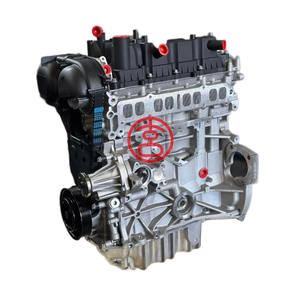Enhance Your Driving Experience with a Reliable Ford Fiesta Engine
Enhance Your Driving Experience with a Reliable Ford Fiesta Engine
Blog Article
Checking Out the Development of Engines: From Classic Layouts to Modern Marvels
From the first vapor engines that powered the Industrial Transformation to the introduction of interior burning engines that transformed wheelchair, each stage has contributed to better efficiency and capacity. As we analyze these landmarks, one should take into consideration how the future of engine style might unfold, challenging our understandings of power and efficiency.
The Birth of Engine Innovation
The development of engine innovation noted a pivotal minute in human development, changing energy conversion and transport. The earliest engines arised from the demand to harness mechanical power for practical usage, leading to the growth of tools that transformed different energy forms right into motion (ford fiesta engine).
The advancement of the interior combustion engine and the innovation of the steam engine militarized a profound shift in industrial abilities. These engines not only enhanced performance yet likewise broadened the scope of human mobility, enabling extraordinary transport possibilities. The early models prepared for the mechanical world, assisting in the increase of industries and reshaping social structures.
As engine designs evolved, they included ingenious products and advanced engineering principles, leading the way for contemporary developments - ford fiesta engine. The birth of engine modern technology sparked a relentless search of effectiveness and power, establishing the stage for the vibrant development of transportation and commercial equipment that would follow
Heavy Steam Engines and Their Impact

The vapor engine's effect was particularly apparent in the transport sector (ford fiesta engine). Steam-powered engines helped with the quick motion of items and people throughout large ranges, effectively reducing the geographical obstacles that had formerly hindered trade and interaction. Similarly, steamships changed marine traveling, permitting quicker and more reliable crossings of rivers and oceans.
In industry, vapor engines powered manufacturing facilities, allowing mass production and the surge of urban facilities as centers of financial activity. Heavy steam technology cultivated developments in engineering and production procedures, laying the foundation for future developments in engine layout.
The Surge of Interior Combustion
Often eclipsing steam power, the surge of internal combustion engines noted a transformative change in transport and market during the late 19th and early 20th centuries. The development of these engines, identified by their capacity to shed fuel within the engine itself, allowed greater efficiency and power contrasted to traditional vapor engines. Introducing innovators such as Nikolaus Otto and Rudolf Diesel played crucial roles in refining engine layouts, bring about prevalent adoption in cars, watercrafts, and commercial machinery.
The inner combustion engine's compact dimension and reasonably lightweight nature helped with the development of personal lorries, reinventing specific movement and reshaping urban landscapes. By making it possible for faster traveling and the efficient transportation of goods, these engines militarized economic development and promoted globalization. The adaptability of fuel options, consisting of gasoline and diesel, better boosted their allure, permitting varied applications across numerous industries.
Regardless of the ecological concerns that would certainly later arise, the first attraction of inner combustion innovation lay in its transformative potential. As culture embraced this innovation, the structure was laid for modern-day transportation systems, developing inner combustion engines as a keystone of industrial innovation and life throughout the 20th century.
Innovations in Engine Efficiency
As interior combustion engines came to be integral to transportation and market, the emphasis changed towards enhancing their effectiveness to satisfy expanding needs for performance and sustainability. imp source Developments in engine layout, material science, and technology have dramatically contributed to this development.
One significant development is the development of turbocharging, which permits raised air intake, leading to more complete gas combustion and improved power result without enlarging engine dimension. Furthermore, variable valve timing systems have been applied to enhance engine performance across various RPM varieties, thus boosting fuel performance.
The usage of advanced gas injection modern technologies, such as straight injection, has also played an essential duty. This approach permits even more exact control over the fuel-air blend, advertising much better combustion and minimizing exhausts. Additionally, lightweight products, including light weight aluminum and composite parts, have actually been adopted to reduce overall engine weight, causing boosted efficiency.
These advancements reflect a wider trend within the automobile market, where the harmony in between engineering development and ecological factors to consider drives the ongoing mission for greater performance in internal combustion engines. As an outcome, modern-day engines are now a lot more effective, cleaner, and effective than ever previously, paving the way for an extra lasting future in transport.
The Shift to Electric Power
With growing problems over environmental influence and nonrenewable fuel source dependence, the automobile sector is experiencing a substantial shift in the direction of electrical power. This shift is driven by a mix of technological innovations, regulative stress, and changing consumer choices. Electric vehicles (EVs) use a compelling option to conventional navigate to this site inner burning engines, boasting minimized greenhouse gas emissions and lower operating prices.
The rise of battery innovation has actually been a game changer, with lithium-ion batteries coming to be much more cost-efficient and efficient. Boosted energy thickness and faster billing capabilities have actually made EVs much more useful for day-to-day usage. Governments worldwide are implementing rewards and establishing enthusiastic targets for phasing out fossil fuel vehicles, thereby accelerating the adoption of electrical power.
As charging infrastructure expands and battery modern technology proceeds to boost, the change to electric power is poised to reshape the auto landscape, advertising sustainability and innovation in the years to come. The future of transport is electrical, and the energy is indisputable.
Final Thought
The evolution of engine technology represents a considerable trajectory of development that has actually profoundly affected transport and market. From the foundational vapor engines to the transformative interior burning engines, each growth has added to enhanced flexibility and economic growth.

Report this page